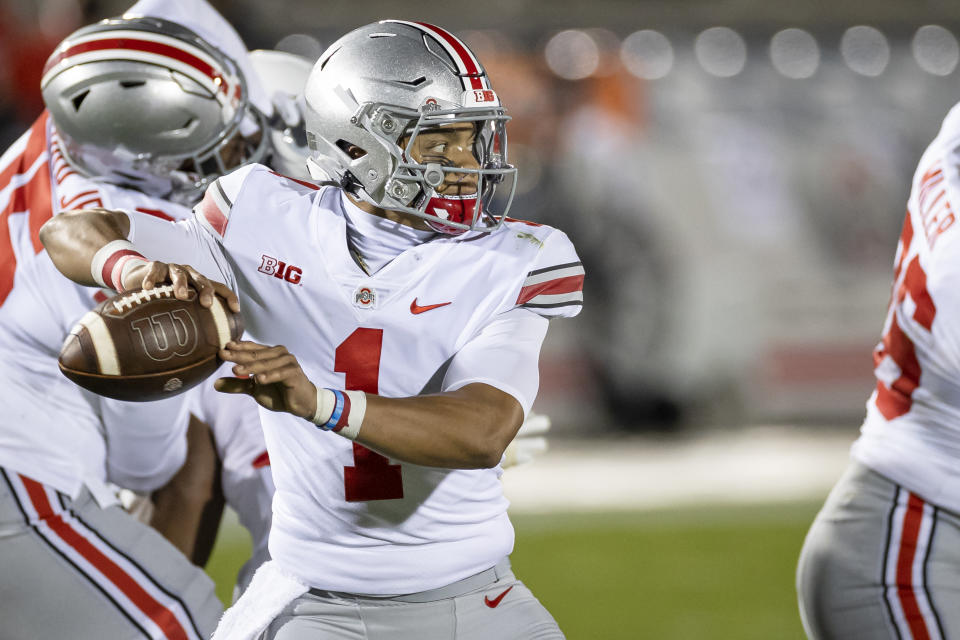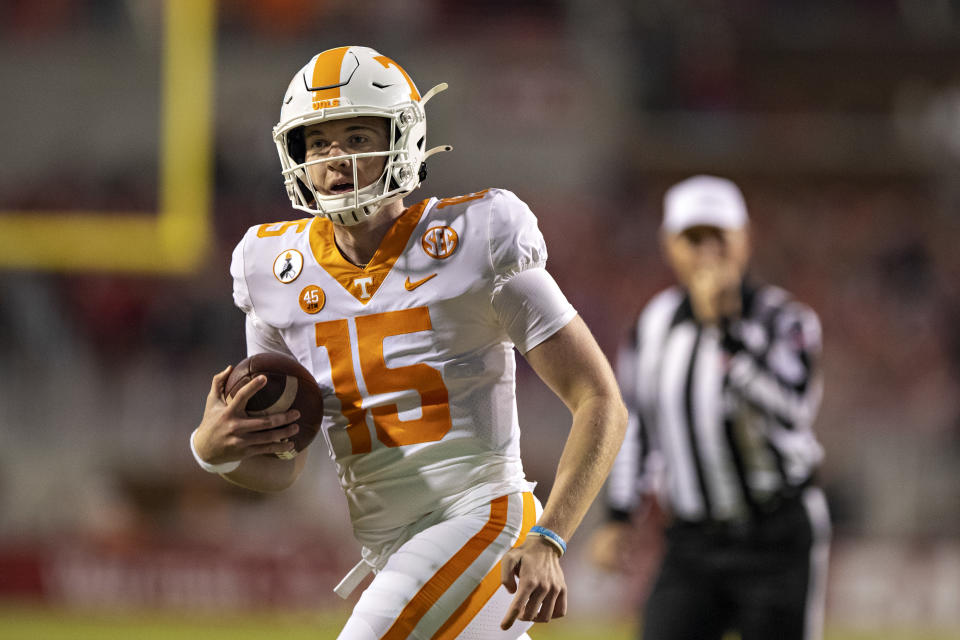Monday Measure: How different would Big Ten be if Justin Fields stayed committed to Penn State?
When Penn State squared off against Ohio State at Beaver Stadium on Oct. 31, the difference in quarterback play was very apparent.
Penn State’s Sean Clifford played a decent game. He completed 18-of-30 throws for 281 yards and three touchdowns, but Ohio State’s Justin Fields was the best player on the field.
In a 38-25 win for the Buckeyes, Fields was 28-of-34 for 318 yards and four touchdowns. He was in total control. His accuracy at all three levels was striking. He stood tall in the pocket and picked apart the PSU secondary for four quarters, finishing the game 6-of-7 on third down and 2-for-2 on fourth down.
Fields played well in OSU’s 2019 meeting with the Nittany Lions, but the biggest impact he made on the PSU program actually came back in June 2017 when he was still in high school.
You see, Fields committed to play for Penn State in December 2016 when he was rated as a four-star recruit by Rivals. But seven months later, Fields, who had since been elevated in the rankings to the No. 1 dual-threat quarterback prospect in the class of 2018, backed away from his commitment to Penn State. It was a decision that changed the trajectory of Penn State’s program.
By October, Fields had committed to stay in his home state and play for Georgia. And after a year of being a backup in Athens, he transferred to Ohio State to play for Ryan Day.
Penn State, meanwhile, was in its final season with Trace McSorley at quarterback in 2018. McSorley led the Nittany Lions past Ohio State to a Big Ten title in 2016, but PSU fell just short of reaching the College Football Playoff. In McSorley’s last two college seasons, PSU suffered heartbreaking one-point losses to the Buckeyes — losses that kept PSU out of the Big Ten title game and a rung below the rest of the CFP contenders.

After that second one-point loss, Penn State coach James Franklin made a now-infamous speech during his postgame press conference. He remarked that PSU had reached the status of being a “great” program, but still had yet to become an “elite” program.
Two years later, it’s beginning to look like Penn State missed its window to become an elite program.
Last year, the Nittany Lions went 11-2 but were again a step behind the Buckeyes in the Big Ten East standings, mainly thanks to a 28-17 loss in Columbus with Fields running the offense on the other side. And in 2020, Penn State is off to a horrific 0-3 start. The play of Clifford has been an issue.
Clifford has been mostly solid for PSU. He’s thrown for 3,708 yards, 34 touchdowns and only 12 interceptions. But he’s only a 58.7% career passer. In Saturday’s loss to Maryland, he completed just 27 of his 57 attempts. That’s a tick above 47%. Meanwhile, Fields has completed more than 70% of his passes during his college career, finished third in the 2019 Heisman voting and looks poised to be a top-10 pick in next year’s NFL draft.
It’s not entirely fair to compare Clifford with Fields, but it is fair to wonder where Penn State might be if it had Fields as its quarterback the last two seasons. Fields has been one of the game’s best players — the type of player that elevates a program from great to elite.
- Sam Cooper
Is it Harrison Bailey’s time at Tennessee?
Tennessee had a halftime lead over Georgia less than a month ago. It feels like it was years ago.
The Volunteers have now lost four consecutive games after starting the season 2-0. And it’s hard to see where that streak will end soon with games coming up against No. 7 Texas A&M and No. 24 Auburn.
A huge reason for Tennessee’s struggles over the last seven halves of football has been the porous play at quarterback. The Vols are averaging just 20.7 points per game — just 19 teams are averaging fewer points — and senior QB Jarrett Guarantano is just 88-of-143 passing for 956 yards and six touchdowns and three interceptions through six games.
Guarantano was replaced by both Brian Maurer and Harrison Bailey in Saturday’s 24-13 loss to Arkansas. Maurer was 0-of-4 passing before Bailey came into the game and the three QBs combined to throw for just 107 yards and two interceptions.
Bailey finished the game and threw both of those interceptions. But with the Vols at 2-4, it’s fair to wonder if he should get the reins for the rest of the season.
The freshman was a five-star recruit according to Rivals and the No. 2 pro-style QB in the country. The only pro-style QB ranked ahead of him was Clemson’s D.J. Uiagalelei. And as you know, Uiagalelei has started the last two games for the Tigers because of Trevor Lawrence’s COVID-19 diagnosis.
Should Tennessee coach Jeremy Pruitt have turned to Bailey sooner? It’s a valid question. Guarantano has been up and down his entire career and hasn’t shown he’s had a solid grip on the starting job this season. While it can be hard to bench a longtime contributor like he’s been, it can also be hard to keep a five-star QB on the bench.

Numerous top programs have shown that they’re willing to let freshmen QB play right away. Lawrence got time at Clemson as a freshman and Uiagalelei saw snaps before he had to be the starter. Tennessee is a program that isn’t contending for a national title. If good teams can play a freshman, why can’t Tennessee?
The Vols could be 4-2 or, at the worst, 3-3 with competent quarterback play. Instead, it’s looking like another lost season in Knoxville. Offensive coordinator Jim Chaney is in the second year of a three-year deal and his offense hasn’t produced nearly enough to justify his hefty contract after he came to UT from Georgia.
If Bailey and Chaney are going to be working together in 2021, there’s no better time than now to test out their working relationship. Five-star QBs don’t sit the bench very often. Especially at programs that aren’t contending for national titles like Tennessee.
- Nick Bromberg
Appreciating Colorado’s improbable win over UCLA
One of the games that slid under the radar on Saturday was Colorado’s win over UCLA.
The Buffs, playing their first game with Karl Dorrell as head coach, jumped out to a 35-7 first-half lead and withstood a second-half rally from the Bruins to win 48-42. UCLA, now in Year 3 under Chip Kelly, was a six-point favorite at BetMGM, so it was a sizable upset for Colorado. And when you consider the challenges the program faced compared to the others in the Pac-12, it was a win that was even more impressive than it may seem on the surface.
For one, Dorrell is Colorado’s third head coach in three years. He was brought in in February after Mel Tucker left Boulder after one season to take the Michigan State job. Tucker’s departure left CU scrambling and it landed on Dorrell, who spent four seasons as an assistant for the Buffs in the ‘90s before a five-year run as the head coach at UCLA. But that run ended in 2007 and Dorrell had mainly served as an NFL assistant in the years since.
The Dorrell hire was not exactly loved by fans and media, but he had no time to dwell in the public perception. He had work to do. Dorrell arrived at a program at a brutal time of the year. It was well after the normal hiring cycle for assistant coaches, so much of his staff was filled by those Tucker did not bring with him to East Lansing. Dorrell was also hired after national signing day, so he had a crop full of new players he did not know, not to mention the roster he inherited.
To make things even more difficult, the COVID-19 pandemic hit. Colorado didn’t have any spring practices, and the work that was done was all done remotely. Dorrell barely had any face-to-face interactions with his players before the Pac-12 decided to play a season in late September.
That left Dorrell and his staff with a lot to accomplish in the weeks that ran up to the Nov. 7 opener. That included naming a starting quarterback. Eventually, the job went to senior Sam Noyer. Noyer arrived at CU as a quarterback but actually ended up playing safety in 2019, contributing mainly on special teams.
Noyer, itching for a chance to play quarterback, entered the transfer portal in the offseason, but was convinced to come back by Dorrell. That paid off for both sides as Noyer won the starting job and threw for 257 yards, rushed for 64 yards and scored two touchdowns in the win over UCLA.
And what a win it was.
- Sam Cooper
More from Yahoo Sports:

 Yahoo Finance
Yahoo Finance 